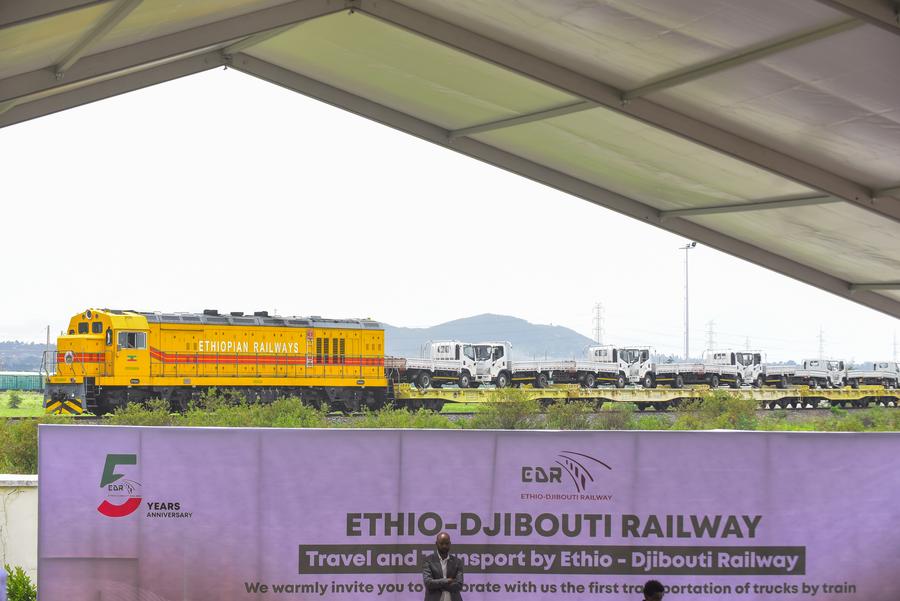China’s diverse cooperation with Africa, particularly in infrastructure, is transforming the continent with projects like roads, railways, bridges, ports, schools, hospitals, and power stations, fostering connectivity and promising a brighter future.
by Yi Xin
When speaking of China-Africa cooperation, the word “kaleidoscopic” comes to mind. Recent years have seen fruitful outcomes of bilateral cooperation in multiple fields. Among them, infrastructure is one.
From the plateau in the east to the coast in the west, from the landlocked countries in the sub-Saharan region to the small island states in the Western Indian Ocean, roads, railways, bridges, ports, schools, hospitals and power stations built with Chinese assistance are paving the groundwork for a better future for a land of promise and potential.
Transport projects drive a more connected future.
“To get rich, build roads first.” This is not just a popular Chinese proverb, but an important takeaway from China’s own development. Drawing on this experience, China has spent decades working with Africa to build the transport backbone necessary for driving economic growth.
It would be remiss not to mention the Addis Ababa-Djibouti railway, a transport artery connecting Ethiopia and Djibouti and the first electrified transnational railway in East Africa. It is a flagship project under the Belt and Road Initiative, and one of the two main lines of transport in the Outlook on Peace and Development in the Horn of Africa which China put forward in 2022 to support regional countries in addressing security, development and governance challenges.
The railway greatly improved the access of countries along the route to the outside world. It has cut transport time for freight goods from more than three days to less than 20 hours, and reduced the cost by at least one-third. To date, the railway has transported 680,000 passengers and 9.5 million tons of cargo, with an average annual growth rate of 39 percent in revenue.
As countries in the region grapple with soaring oil prices, the electrified railway has played an increasingly important role in delivering essential materials such as edible oil and fertilizers to meet the needs of socioeconomic development.
In May this year, Chinese contractors handed over the railway’s management and operation to the African side after six years of smooth operation. Ethiopian Minister of Finance Ahmed Shide said, “The Addis Ababa-Djibouti railway line is an example of the ever-flourishing Sino-African relations. The Sino-African partnership has passed the test of time, demonstrated its resilience, and marks a brighter and strong future.”

In recent years, more and more infrastructure projects in Africa undertaken by China have yielded tangible benefits, often exceeding the traditional transport domain. Since the establishment of the Forum on China-Africa Cooperation (FOCAC) in 2000, according to the “China and Africa in the New Era: A Partnership of Equals” white paper, Chinese companies have helped African countries build or upgrade more than 10,000 km of railways, nearly 100,000 km of highways, roughly 1,000 bridges, almost 100 ports, 66,000 km of power transmission and distribution, an installed power-generating capacity of 120 million kW, a communications backbone network of 150,000 km, and a network service covering nearly 700 million user terminals.
Blue economy cooperation cultivates talent.
The ocean connects countries, bearing infinite hope. In recent years, under the “Vision for Maritime Cooperation under the Belt and Road Initiative” and the “Belt and Road Blue Cooperation Initiative,” China has taken concrete steps to forge a blue partnership with Africa.
In the China-Africa Cooperation Vision 2035 released at the eighth FOCAC Ministerial Conference in 2021, cooperation on the blue economy is listed as a “new growth area” that can “add value to and sustainably utilize marine resources.” The infrastructure projects in this field have created many local jobs and helped train much-needed engineers, technicians and other skilled professionals for Africa.
The Lamu port project in Kenya is an example. It has an important place in Kenya’s Vision 2030, the country’s long-term development blueprint. Built by a Chinese company, the port is part of Kenya’s bid to become a major trading hub in East Africa.
Over three-quarters of the project’s hires were African. Chinese companies send experienced and skilled Chinese workers to provide on-the-job training to local recruits. This was met with great enthusiasm among young Africans. More than 2,500 job opportunities with such tailored training have produced many skilled workers. After the project was completed, they were able to find new jobs and lead better lives with the skills they mastered.
Green economy cooperation supercharges energy transition.
China has been an important partner in Africa’s green transition. To date, China has undertaken more than 100 clean energy projects under the FOCAC framework, supporting African countries in making better use of clean energy such as solar, hydro, wind and geothermal power.
The De Aar Wind Farm has changed the energy landscape of South Africa. As the first wind power project financed, constructed and operated by a Chinese company in Africa, it supplies 760 million kilowatt-hours of clean electricity annually, meeting the electricity needs of 300,000 households. This has contributed to closing the gap caused by unstable clean energy and addressing the electricity shortage in South Africa.
China’s continuous efforts to help develop infrastructure in Africa over the decades are rooted in Confucian philosophy. To quote The Analects, “The man of virtue, while establishing himself and pursuing success, also works to establish others and enables them to succeed as well.” In other words, in pursuing its own development, China sincerely hopes to see African countries, which are also important members of the Global South, become prosperous and strong.
Editor’s note: Yi Xin is a Beijing-based observer of international affairs.
The views expressed in this article are those of the author and do not necessarily reflect those of Xinhua News Agency.■
